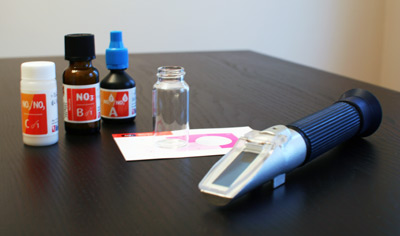There’s an old saying that only bad things happen quickly in a marine aquarium. That’s certainly true enough, but it’s also important to keep in mind that some problems that can affect the health and wellbeing of livestock tend to develop very gradually and almost imperceptibly over time. Here’s a quick (but by no means exhaustive) list of some of the sneaky marine aquarium problems that we must be vigilant against:
1) Downward drift in pH
Maintaining a stable pH in the desired range of 8.2 to 8.4 demands careful monitoring, conscientious livestock husbandry, and diligent maintenance. Neglect in any of these areas can cause your pH to drift off course, and the trend is usually (though not always) downward as a result of the natural biological processes going on in the tank. In addition to regular water testing, your best hedges against drifting pH are:
- Performing regular partial water changes
- Maintaining an appropriate alkalinity level (between 8 and 12 dKH)
- Providing turbulent water movement at the surface to drive off carbon dioxide
- Avoiding overstocking and overfeeding
2) Loss of light intensity
The gradual loss of intensity in aging aquarium lamps isn’t necessarily a big deal for fish-only and FOWLR tanks, but it can lead to significant problems in a reef system. Not only will the inadequate light level stress your photosynthetic invertebrates, but if you’re not careful, they can also be shocked a second time by the sudden increase in light intensity when you finally replace the lamps.
Don’t assume you’ll notice the difference in the output of your aquarium lighting because you won’t until it has grossly decreased. It’s best to replace your bulbs/tubes regularly according to the schedule recommended by the manufacturer.
Also, be aware that yellowing compounds in the water and salt/calcium buildup on lids and cover glasses will tend to reduce the level of light reaching photosynthetic invertebrates and that suddenly eliminating these issues (e.g., by using activated carbon to polish the water or cleaning the lids and cover glasses) can cause a spike in light intensity that shocks the inverts as well.
3) Slipping salinity
Several factors can cause the salinity of a marine aquarium to drift gradually away from the desired value, among them:
- Failing to compensate for evaporation by topping off with fresh water
- Compensating for evaporation with salt water instead of fresh water
- Failing to exactly match the salinity of replacement water to that of the dirty water being removed during water changes
- Adding more or less salt water than you remove during water changes
- Failing to compensate for salt creep
Salt creep—the crusty buildup of salt on surfaces exposed to air and saltwater spray—is probably the salinity-reducing factor that, well, creeps up on hobbyists most often. Wiping away this buildup is an important routine maintenance chore, but don’t forget that every bit of salt creep you wipe away was once dissolved in the tank water. You need to compensate for this loss.
4) Rising nitrate
All the issues we’ve discussed thus far have been related to falling levels. When it comes to nitrate, however, the level is always trending upward. That means, in addition to avoiding overstocking and overfeeding, marine aquarium hobbyists have to employ some sort of nitrate-reduction methodology to keep nitrate from gradually climbing to an unacceptable level.
Diluting nitrate with good-old-fashioned water changes is the tried-and-true approach. Other nitrate-reduction techniques, such as the use of a deep sand bed or an organic carbon source coupled with protein skimming, can be helpful as well (though they should not be considered substitutes for regular partial water changes).
Put your water to the test!
The potential for such sneaky problems is one of the best reasons to test your water parameters on a regular basis. Remember, the earlier you catch one of your parameters drifting off course, the easier it is to rectify and the less stress it will cause your livestock.



